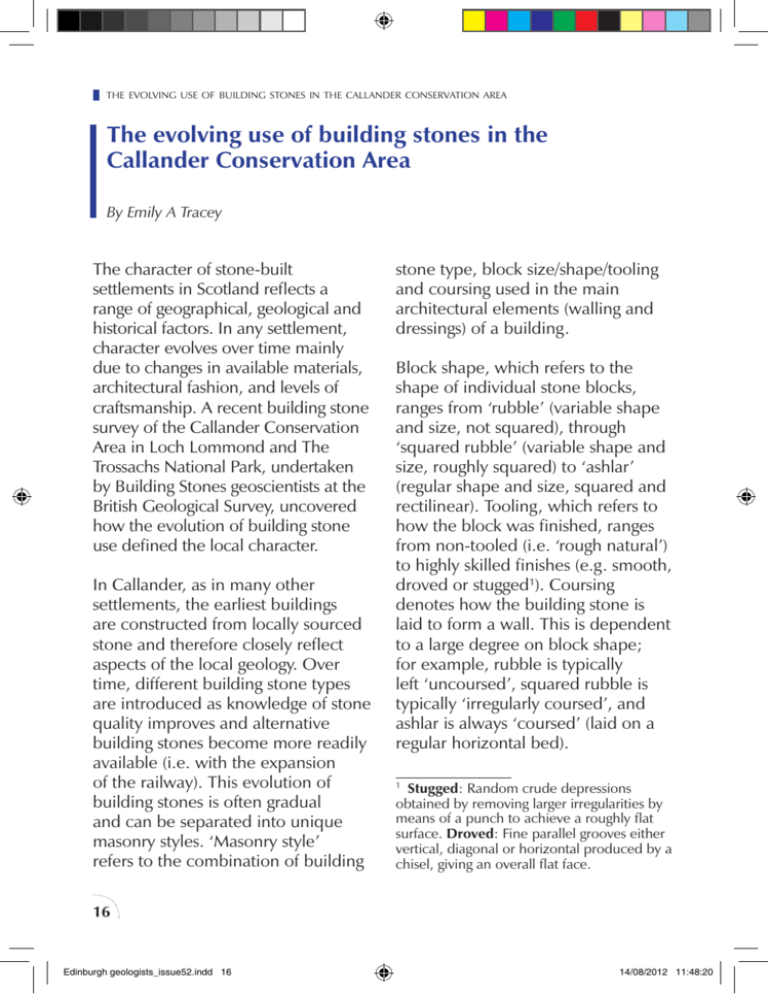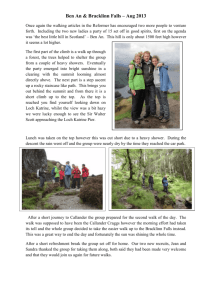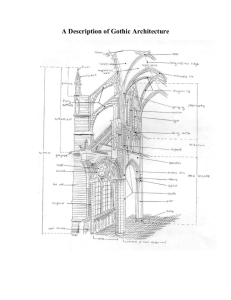
the evolving use of building stones in the callander conservation area
The evolving use of building stones in the
Callander Conservation Area
By Emily A Tracey
The character of stone-built
settlements in Scotland reflects a
range of geographical, geological and
historical factors. In any settlement,
character evolves over time mainly
due to changes in available materials,
architectural fashion, and levels of
craftsmanship. A recent building stone
survey of the Callander Conservation
Area in Loch Lommond and The
Trossachs National Park, undertaken
by Building Stones geoscientists at the
British Geological Survey, uncovered
how the evolution of building stone
use defined the local character.
In Callander, as in many other
settlements, the earliest buildings
are constructed from locally sourced
stone and therefore closely reflect
aspects of the local geology. Over
time, different building stone types
are introduced as knowledge of stone
quality improves and alternative
building stones become more readily
available (i.e. with the expansion
of the railway). This evolution of
building stones is often gradual
and can be separated into unique
masonry styles. ‘Masonry style’
refers to the combination of building
stone type, block size/shape/tooling
and coursing used in the main
architectural elements (walling and
dressings) of a building.
Block shape, which refers to the
shape of individual stone blocks,
ranges from ‘rubble’ (variable shape
and size, not squared), through
‘squared rubble’ (variable shape and
size, roughly squared) to ‘ashlar’
(regular shape and size, squared and
rectilinear). Tooling, which refers to
how the block was finished, ranges
from non-tooled (i.e. ‘rough natural’)
to highly skilled finishes (e.g. smooth,
droved or stugged1). Coursing
denotes how the building stone is
laid to form a wall. This is dependent
to a large degree on block shape;
for example, rubble is typically
left ‘uncoursed’, squared rubble is
typically ‘irregularly coursed’, and
ashlar is always ‘coursed’ (laid on a
regular horizontal bed).
Stugged: Random crude depressions
obtained by removing larger irregularities by
means of a punch to achieve a roughly flat
surface. Droved: Fine parallel grooves either
vertical, diagonal or horizontal produced by a
chisel, giving an overall flat face.
1
16
Edinburgh geologists_issue52.indd 16
14/08/2012 11:48:20
the evolving use of building stones in the callander conservation area
Four masonry styles (i.e. particular
combinations of stone type, block
size/shape/tooling and coursing used
in the main architectural elements
of a building) define the Callander
Conservation Area (CCA), each
reflecting the available building
materials, architectural tastes and
masonry skills of the time. The
main changes in masonry style can
be linked to events affecting the
availability of materials, in particular
the opening of quarries in the local
area (providing a reliable but restricted
source of local building stone), the
arrival of the railway (bringing a variety
of stone and slate types from other
parts of the UK), and the impact of
the First World War (associated with
a rapid decline in the number of
operational building stone quarries in
the UK, and a shift to ‘modern’, manmade building materials).
The town is centred on Main Street, the
principal (oldest) part of which is around
0.75 kilometres long. Near its central
point the street opens out on both sides
into Ancaster Square, but is otherwise
lined by buildings fronting directly onto
it. A regular, grid-like street pattern is
developed in the area immediately
around Main Street, beyond which are
areas of grand Victorian villas (notably
Figure 1 Map of the town of Callander and outline of the CCA. OS Map
© Crown Copyright 2011. All rights reserved. BGS 1000372272.
17
Edinburgh geologists_issue52.indd 17
14/08/2012 11:48:21
the evolving use of building stones in the callander conservation area
Figure 2 Local building stones of Callander sourced mainly from three longdisused quarries located to the north of Callander (conglomerate) and in Lenny
Feus (flagstone). Top left: typical early mixed rubble wall found in conservation
area; top right: conglomerate building stone; bottom left: typical brown-grey
flagstone, often face-bedded and mainly used as dressings; bottom right: typical
purple-red flagstone, mainly used as building stone in the villas of Lenny Feus.
Leny Feus) and modern housing.
The Callander Conservation Area is
broadly centred on Main Street and
encompasses several hundred stone
buildings (Figure 1).
Three of the most important
stone types used in Callander
buildings — conglomerate (Callander
puddingstone), and two types of
flagstone — were sourced locally,
from three long-disused quarries
in the wooded slopes north of the
town centre (Figure 2). Each quarry
exploited a separate division of the
Old Red Sandstone Supergroup
18
Edinburgh geologists_issue52.indd 18
14/08/2012 11:48:21
the evolving use of building stones in the callander conservation area
Figure 3 Map of simplified bedrock geology in the Callander district. Callander
straddles the outcrop of several major mapped ‘Old Red Sandstone’ divisions of
conglomerate, sandstone and flagstone on the northwest limb of the Strathmore
Syncline. © NERC 2011. All rights reserved.
exposed adjacent to the Highland
Boundary Fault (Figure 3).
Historically, Callander occupied a
strategically significant transit point
for trade between the Highlands
and Lowlands in Scotland. Town
expansion was thus greatly influenced
by the trade and manufacture of
agricultural goods from as early
as the 17th century. Early village
development was focused around
Bridgend, on the south side of River
Teith (Figure 1). This area retains its
historical feu patterns and remnants
of 17th century building foundations.
By the end of the 18th century, the
population of Callander exceeded
1000 for the first time. Development
was focused in Ancaster Square and
along Main Street. A daily coach
to Stirling carrying passengers and
delivering post began in 1835 and the
19
Edinburgh geologists_issue52.indd 19
14/08/2012 11:48:21
the evolving use of building stones in the callander conservation area
first railway station in Callander was
opened in 1858. The railway had a
significant impact on the development
of Callander, bringing people, trade,
and new building materials to the
town. Many important commercial,
religious and civic buildings, including
hotels, banks, churches and schools,
were built during the latter half of the
19th century, as were the impressive
residential villas of Leny Feus. Villa
developments soon subsided along with
a general use of stone in construction
with the passing of Victorian times,
the significant consequences of two
World Wars, and the depression of
the 1920s, not just in Callander, but
across the United Kingdom.
Masonry styles
Four masonry styles are recognised in
Callander, each characterised mainly
by a particular combination of stone
types used in walling and dressings.
Each is described below with a
selection of typical examples.
Masonry Style 1
Buildings of the earliest masonry
style (Masonry Style 1; Figure 4) are
long, low structures with walling
and dressings composed of mixed
stone rubble sourced from fields
and river beds. The rubble walling
comprises cobbles and boulders of
local conglomerate (puddingstone)
and siltstone (flagstone, mostly of
the red type), dolerite and other
Figure 4 Example of Masonry Style
1. 18th century mixed stone rubble
constructions of Ancaster Square
North (rear feu plots). The early constructions contain very large spans of
stone for dressings, some of which
still retain extraction tooling marks.
basic intrusive igneous rocks (whin),
metavolcanic rocks (greenstone)
metasandstone, schist and gneiss.
The buildings are located in the
oldest parts of the town, notably in
Bridgend and Ancaster Square. They
are generally very simple constructions
of mixed rubble walling and dressings
formed of variably shaped blocks,
with relatively small fenestration and
little architectural detailing. Dressings
are often large spans of stone, some
of which retain the original extraction
tooling marks. Large boulder footings
were characteristically used along
the base course of the buildings. This
feature, which is common in early
buildings, was designed to provide
20
Edinburgh geologists_issue52.indd 20
14/08/2012 11:48:21
the evolving use of building stones in the callander conservation area
protection against rising damp and
to provide a strong foundation. Large
blocks of stone were often used in
combination with small flaggy pieces
of stone. For this reason, uncoursed or
irregularly coursed rubble with rough
natural finishes is characteristic of this
masonry style.
Masonry Style 2
This masonry style is characterised
by the first use of local grey-brown
flagstone dressings in combination
with mixed rubble walling, and
by the appearance and eventual
dominance of walling consisting
entirely of conglomerate. It is a
feature of late 18th to mid- 19th
century buildings (Figure 5).
These changes may partly reflect
a reduction of the mixed stone
resource, and partly the need for
reliable, sustainable local stone
resources as town development
became more organised. Local
quarries would have opened to
provide the building stone needed
for new construction.
The markedly heterogeneous texture
of the conglomerate makes it very
difficult to work, and in the earliest
examples conglomerate walling
consists of uncoursed random rubble
with a rough natural finish. The local
grey-brown flagstone dressings were
commonly stugged or droved. This
masonry style occurs throughout the
Figure 5 Example of Masonry Style
2. Late 18th century construction on
Main Street built of mixed stone rubble and conglomerate walling with
grey-brown flagstone dressings.
Callander Conservation Area, most
commonly in Ancaster Square and
along Main Street. The buildings
were constructed as part of a major
development undertaken by the
Commissioners for Forfeited Estates,
who administered the lands forfeited
by landlords who had supported the
1745 Jacobite rebellion.
The buildings are generally very simple
constructions, similar architecturally
to those of Masonry Style 1. They
are attached builds with gable end
chimneys and widely spaced windows
flanking a central door; however,
unlike Masonry Style 1, most of the
buildings have two storeys (though
in some cases the second storey is a
later addition). The walling is typically
irregularly coursed, random rubble
21
Edinburgh geologists_issue52.indd 21
14/08/2012 11:48:21
the evolving use of building stones in the callander conservation area
Figure 6 Examples of Masonry Style 3. St. Kessog’s (1868) and Robertson
House (mid 19th century) built of locally sourced walling stone (conglomerate
and flagstone) with imported sandstone dressings. This masonry style is the
most commonly used throughout the CCA.
conglomerate with a rough natural
finish. Commonly, the rubble walling
is ‘lined out’ to imitate ashlar masonry.
The dressings are of local grey-brown
flagstone, commonly stugged.
Masonry Style 3
This masonry style is characterised
by walling of local Callander stone
(conglomerate and flagstone)
and dressings of imported
Scottish sandstone (Figure 6). The
appearance of imported sandstone
dressings coincides with the
opening of the Dunblane, Doune
and Callander Railway in 1858,
which stimulated a rapid expansion
of the town and a rise in tourism.
Large, regular-sized blocks of buff
sandstone and red sandstone began
to replace the dressings of locally
sourced grey-brown flagstone. The
sandstone dressings were commonly
droved, high quality ashlar blocks.
Compared to the locally sourced
flagstone, the imported sandstone
would have been attractive
because it was available in larger
blocks (making it more suitable for
dressings), and was easy to carve.
Villas were constructed by the
wealthy for summer homes and,
in some cases, as permanent
residences away from the city. A
new development of villas expanded
rapidly at Leny Feus. For these
buildings, the typical masonry
style is purplish-red flagstone
walling and imported Scottish
sandstone dressings. The use of the
purplish-red flagstone walling is a
characteristic feature of the Leny
Feus area, reflecting the fact that
the development is adjacent to the
Leny Feus Flagstone Quarry; it is the
22
Edinburgh geologists_issue52.indd 22
14/08/2012 11:48:22
the evolving use of building stones in the callander conservation area
Figure 7 Examples of Masonry Style 4. The Old Bank on Main Street (C(s)
listed, 1883) and building on Bridge Street (C(s) listed, late 18th century); both
built of imported sandstone walling and dressings.
only part of the CCA in which this
flagstone is the dominant stone type.
Masonry Style 3 is most common in
buildings constructed in the period
following the arrival of the railway (mid
to late 19th century), but it continued
to be used until the early 20th century.
It is the most common masonry style in
the Callander Conservation Area, and
occurs in all parts of it.
Masonry Style 4
This masonry style is characterised
by the use of imported sandstone for
both walling and dressings (Figure
7). It first appears after the arrival of
the Dunblane, Doune and Callander
Railway in 1858 and was used in
buildings until the First World War.
Large, regular-sized, smooth ashlar
blocks of regularly coursed buff
sandstone and red sandstone were
used in the construction of many of
the larger, more important Callander
buildings of this period, such as
banks, hotels and churches.
Many buildings displaying this
masonry style are located on Main
Street. In most cases, older buildings
would have been demolished to
redevelop corner sites at cross streets
and other prominent locations.
Masonry Style 4 is also characterised
by ornate carving and detailing.
The relatively soft, homogeneous,
imported sandstone allowed masons
to produce a level of detail that was
not possible with the hard, pebbly
conglomerate. As a result (and in
line with a widespread, general
improvement in masonry skills),
facades became more detailed
23
Edinburgh geologists_issue52.indd 23
14/08/2012 11:48:22
the evolving use of building stones in the callander conservation area
with architectural elements such as
string courses, cornicing, large bay
windows, parapets and towers.
Conclusion
Four distinct masonry styles are
recognised in Callander buildings,
each characterised mainly by the
combination of stone types used
for walling and dressings. The first
appearance of each masonry style
typically reflects a change in the
availability of stone building materials
as the town developed. The main
events affecting the availability of
materials were: the opening of local
quarries (c.18th century); the arrival
of the railway in the second half of
the 19th century; and the First World
War (which coincided with the rapid
demise of the building stone quarry
industry in Scotland). With just a few
exceptions, natural stone has not been
used in buildings constructed since the
First World War, leading to a gradual
dilution of the traditional character of
the built heritage in Callander.
Locally sourced conglomerate
(‘Callander puddingstone’) is the
most widely used natural stone
building material in the Callander
Conservation Area. The conglomerate
is an unusual building stone in terms
of its appearance and the fact that
it is not easy to work (compared to
sandstone and flagstone, for example).
Nevertheless, it was used at all stages
of town development up to the First
World War. For much of this time,
other widely available, easy to use
and popular building stones were
available, raising the question of why
the conglomerate remained popular in
Callander for so long. The locals may
have been aware of its importance to
the character of their town and its sense
of identity. Alternatively, the importance
of maintaining the local quarrying
industry (and the associated jobs) may
have over-ridden the aesthetic and
economic reasons for using imported
stone. Today, the conglomerate plays
an important role in defining the
‘sense of place’ within the CCA.
Although imported stone has been used
extensively, and man-made materials
are used almost exclusively in modern
buildings, the widespread and long-term
use of locally sourced conglomerate,
flagstone and slate has ensured that
the built heritage within the Callander
Conservation Area continues to reflect
the local bedrock geology.
Emily A Tracey
Building Stones Conservation
Specialist
British Geological Survey, Edinburgh
Acknowledgements
This paper is published with the
permission of the Executive Director,
BGS (NERC).
24
Edinburgh geologists_issue52.indd 24
14/08/2012 11:48:22








